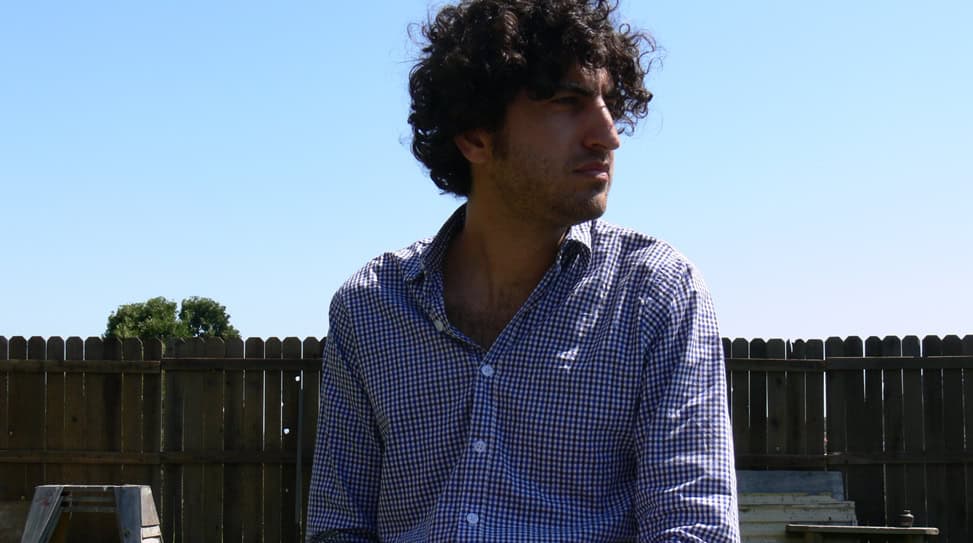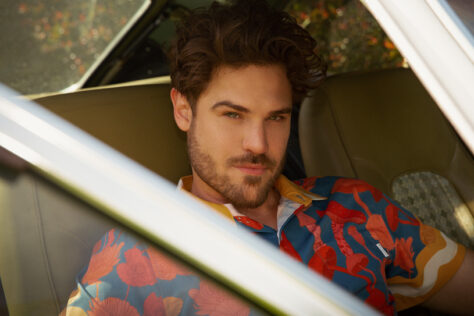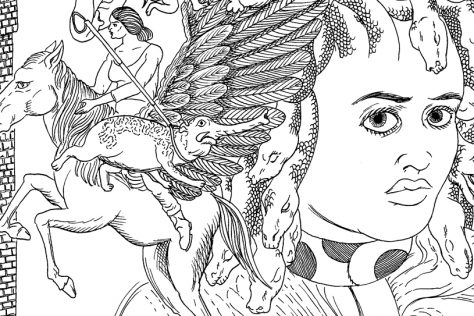After cementing a successful directing career in music videos and commercials under the moniker Josh & Xander (with directing partner Xander Charity), Josh Melnick premieres his first solo art exhibition with The 8 Train. The series of black and white portraits were born out of the artist’s fascination with technology’s potential for artistic expression and its resultant socio-cultural impact.
The portraits of passengers on the NYC subway were filmed with a scientific camera that’s capable of shooting at incredibly high frame rates. Therefore, the images play back in super slow motion, at once boasting the aesthetic and technical qualities of photography and film (a similar technique can also be seen in the duo’s intoxicating video for Cat Power’s “Where is My Love”). The artist’s intention is to reorient the viewer’s perception on human relationships, specifically the exchange between strangers in an intensely public setting. The train’s passengers come from all walks of life, but they’re essentially cut from the same cloth, so to speak.
Melnick screened some of the stunning portraits for Anthem earlier this month. It seems to be an auspicious beginning for his turn as an artist. The 8 Train exhibit is up at Art in General in New York until July 18. We highly recommend that you go check it out!
I understand that you studied sculpture at Yale. What pulled you in that direction?
I never really studied traditional sculpture. I guess I did in high school, but I went to Yale because my interest in art was conceptual and I wanted to be part of a program where I would be able to use many different mediums to explore ideas. So while I was studying sculpture, I mostly did video and installation work.
Do you find that what you learned in that program informs your current creative process in commercials, music videos, and various art projects?
Completely. To me, there really is no distinction between working in the studio and working in the commercial world as far as how I initially approach the ideas and what my intention is. The form is totally different, obviously—the form of a video and the form of an installation. But the process behind it is identical, at least in the ground stages.
Can you talk a little bit about what The 8 Train is about?
The 8 Train was commissioned by Art in General, which is a non-profit contemporary arts organization in New York. For the project, I basically went into the subway and shot a series of portraits of people riding the train with a high-speed video camera. The idea was to shoot portraits of people over a very limited amount of time in extreme slow motion. The camera itself shoots at 1,300 frames per second and records for about 2 seconds of real time. Within those two seconds, we would move the camera around the subjects and shoot a portrait as they were doing whatever it is that they were doing on the subway. I was interested in capturing that trance-like state that people get in when they’re on the subway—they’re looking at something, but avoiding looking at anybody else. This is the subject of the project, but what it’s really about is rethinking the way we look at others, ourselves, and the world. I was interested in using this suspension between still photography and cinematic motion to call attention to the psychological processes of seeing. The technique is an excuse to ask certain questions about perception.
Was the concept for The 8 Train born directly out of the Cat Power video that you shot with Xander?
I came up with the idea for The 8 Train around the same time as the Cat Power video. For years, Xander and I have been experimenting with high-speed video and film-based photosonics, and working on ideas that would eventually become some of the work we did for MAC Cosmetics, The Stills, and then finally Cat Power. I put the 8 Train idea on hold because I was concentrating my practice mostly on video concepts, and I really thought that the idea could be expressed in some form in that particular video. The Cat Power video was an excuse to deeply look, stare really, at people just like The 8 Train is about looking at people. It was in many ways successful, but it was inherently limited because of the music video genre—mostly the 3-minute time frame of the song and the narrative of the woman falling that had to be woven into the concept in order to make it work as a video. I realized during the editing process that all I wanted to do was watch the dailies, more than the edited video even. The extended process of looking at people’s gazes in extreme slow motion and the way these images seemed to move from being very specific to quite abstract became interesting to me. You start out thinking, “Oh, this person is so and so”—you create a little story in your head—and then by the end of the shot you realize that what that person “is” is largely a result of what meanings you project onto their image. It’s something that I realized I needed to explore in a gallery setting. Each of the portraits in The 8 Train lasts for 3 – 4 minutes even though they’re only documenting about 1-2 seconds of someone in real time.
Were you pretty much set on using the New York subway as the backdrop for the portraits or did you have other locations in mind as well?
The subway was the only place to shoot this project. Not only because of the photographic history of reportage photos of people on the subway that in some ways this project references, but because the subway itself creates a liminal trance-like state in people—it rocks back and forth, it’s dark, and it’s underground. There’s something very dreamlike about the subway to begin with and it’s also the place where there are barriers between people, these unspoken barriers. I grew up in NYC and have spent so much time on the trains. I’m fascinated by them.
What role does the absence of sound and music play in these pieces?
There’s going to be absolutely no sound when the portraits are shown. If I had the budget, I would’ve built a sound deprivation chamber to show them in. If you hear any sound at all, it’ll simply be the hum of the fan from the projectors. The piece is designed to have as few specific or manipulative elements about it as possible. Any sound manipulates an image and sometimes it really works to your advantage as a filmmaker. But in this piece, I really wanted the portraits to be as neutral as possible, and as silent and meditative as possible.
Did you get a permit to shoot on the subway or was it shot guerrilla-style?
Totally guerrilla-style. I think Max [Goldman] and I are still on the MTA’s most wanted list. [Laughs]
Do you recall any other roadblocks you faced while you were in production with this project? Were there any technical elements that were particularly difficult to overcome?
Well, just figuring out how to retrofit the Vision Research Miro camera to a place where we could use it handheld on the subway took a bit of technical fiddling around—getting it to run off a battery belt, finding the lens with the right look and speed, how to adapt it to the camera and so on. Max and I did a lot of tests in the subway, and we spent a bunch of time working with the guys at Vision Research and TCS camera to get it all sorted out.
How did you go about casting for the portraits? Are these actors or people you simply grabbed off the street?
Most of the people in the exhibit are real people we came across in the subway. I would basically wander through the trains until someone caught my eye. I couldn’t describe specifically what it was that I was looking for if I had to write a breakdown for a casting director, but it was about trying to find people I was intrinsically drawn to and who also didn’t have any “loud” features. No one is ordinary, but they needed to be able to fade away in a sense for the piece to work—no one with a crazy style or really obvious hair, for instance. This project wasn’t about creating a style survey of New York or even about trying to document in some anthropological way the various faces one might find in the MTA. It’s more timeless and abstract than that. It was fun to break down the typical social barriers on the subway and interact with people.
Creating a sense of “documentary” realism in cinema often requires manipulation. I was always more interested in making moments that felt real and worked as real on a visceral level, whether or not they necessarily were real. The idea was to find and use mostly real people, but each day, I brought about 5 “extras”—people I had cast from faces in an extras book—down into the subway with me. I would shoot them when no one else would agree, and sometimes use them as “bait” so that when other people on the train saw someone else getting their portraits taken, it would be less threatening to them and they would be more open to participating. The funny thing is, in the end, I cut most of the extras out of the exhibition. For whatever reason, maybe only to me, their portraits didn’t have exactly the quality that I was after.
How many people did you end up shooting and from that collective pool, how many are you showing in the gallery?
It’s not something that I’m telling people because I don’t want anyone to feel like they can or should stay in the gallery to see every single portrait. There is no beginning or an end. There are so many portraits that you would have to stay a really, really long time to see them all. I wanted to shoot an overwhelming amount. They’re on these randomized projectors, which mean that you’ll never see the same exhibit twice and the combination of portraits shown will always be different.
Just going back to shooting with high-speed cameras… I think a lot of video directors tend to use slow motion as an effect somewhat carelessly. Why are you personally attached to this technique?
I’m kind of old fashioned in as far as what I think art should do. I love exploring visual ideas as much as the next guy, but I feel that the ultimate purpose of art is to literally change people’s perception of the world. If you change the way someone sees the world, you can change infinite things from human interactions to political power structures. Seeing very simple things in a subtly new way can have a profound effect. As soon as you call something into question, you can call everything into question. My attachment to this technique is about being able to look at something familiar in an unfamiliar way and asking the question, “What does it mean when you do that?” It’s not about the technique, per say—I could care less about that—it’s just a formal means to an end. For me, it’s about the effect that the slow motion technique may have on people. It’s a reminder of how uncanny and infinite our world actually is.
I’ve been posing this question to various video directors lately since there seems to be an intense dialogue going on about it in the community: What are your thoughts on the current state of music videos and where do you think the industry is headed?
Right. Well, there are definitely way fewer opportunities nowadays for artistic expression in videos, not only in terms of budgets, but also in terms of risks that are willing to be taken by labels. As far as where I see it going…I don’t know if I can talk about that right now. [Laughs]
What do you think is attributed to this fear of taking risks on the part of labels?
I don’t really know. I mean, I know that when there is less money and people are losing their jobs, it breeds a culture of fear. It means that when money is spent, people become much more conservative. It’s really sad for me because I feel like music videos are kind of becoming a lost art form. You might have some labels that are willing to take risks, but they also only have like $5,000 to make the video. There are some amazing videos that you could get for that much, but a lot of ideas that you simply can’t produce on that budget. That being said, I love making music videos and Xander and I will keep on writing treatments like a scab that needs picking.
What’s next on your agenda?
I have a few more art projects that I’m working on—a shoot coming up for one of those and another piece that’s more of a public performance. I’m also working with Angie Keefer and Art in General on a book project about The 8 Train exhibit. Of course, there’s a whole roster of commercials and some potential videos on the horizon with Xander as well as a feature project, a road movie that I’m developing.

 Second Nature: Grey Damon
Second Nature: Grey Damon A Conversation with Dash Shaw
A Conversation with Dash Shaw
No Comments